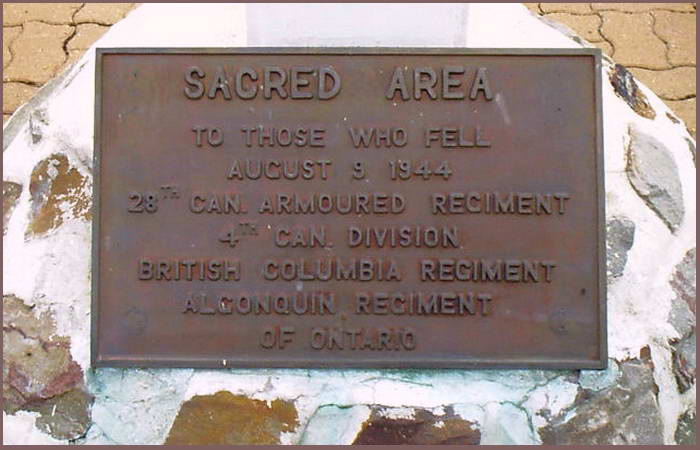
In September 2004, I visited Hill 140, 15 kilometers west of St-Pierre-sur-Dives on
the road D 131 between Maizières and Estrées-la-Campagne. Here was and still is a remembrance
point for the men who fought so desperately against a German enemy who were not willing to give up
their ground. This place is one of many to remember the fallen for freedom. I noticed a small
picture with some scribbled words on the back. I thought it was a nice picture to include on my pages.
Without permission of the owners of the small token, I took some photo's of the picture and placed it on my website.
In the back of my mind, I found it a pity that I could not give notice to the son of Corporal Massey.
Almost a year past, and on August, the 15th, 2005 I received a mail from Sean, son of E.L. Massey
that by truly coincidence he came across my pages and saw to his surprise the picture of his father.
He told me the whole story and I like to share it with you. The following is a story that so many of the
other nameless heroes could tell, but this one tells it all. I give it as Sean has given it to me.
I salute you, Lance Corporal E.L. Massey.
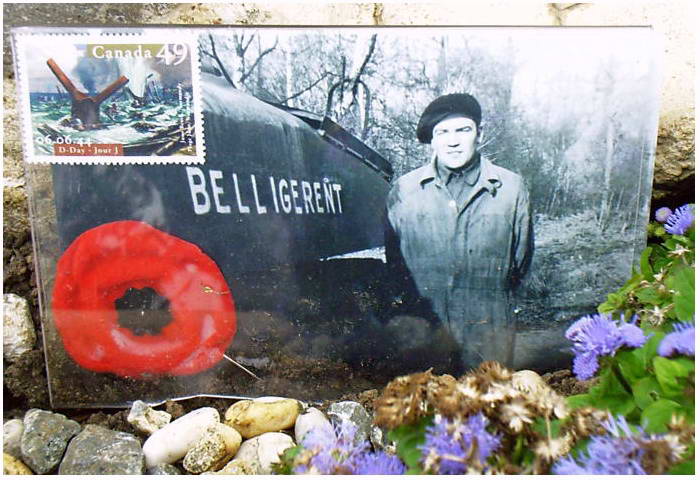
Sean; "We visited the battlefield September 20th 2004 and left the picture & note there at that time.
I hope it lasts there a while........ but nothing lasts forever........... The red poppy with the note/picture
is one of thousands that is worn by Canadians on November 11 every year in remembrance of the fallen of both world wars."
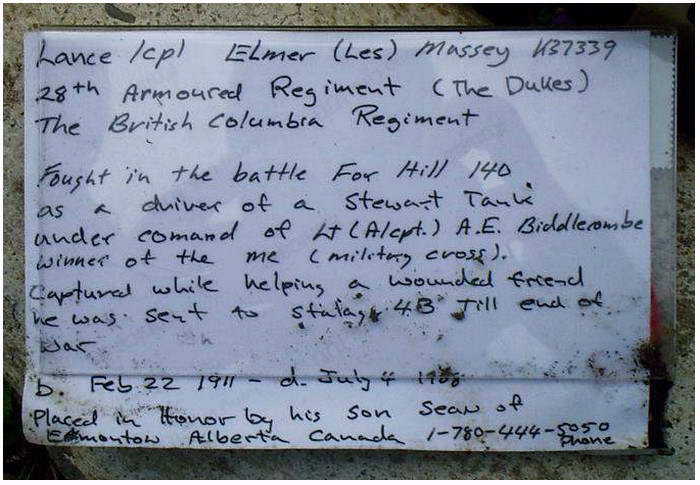
On the back of the picture,
there was this note,...
"I grew up with him telling stories of the bloody battle for hill 140, I had told him that some day
I would go to France and see the battle site for myself. I was pleased to see such a fine monument placed
there, I know my dad would have been surprised and proud that the site was recognized at all. We also
visited the Canadian cemetery at Bretteville-sur-Laize, where my dad's friends and fellow soldiers rest."
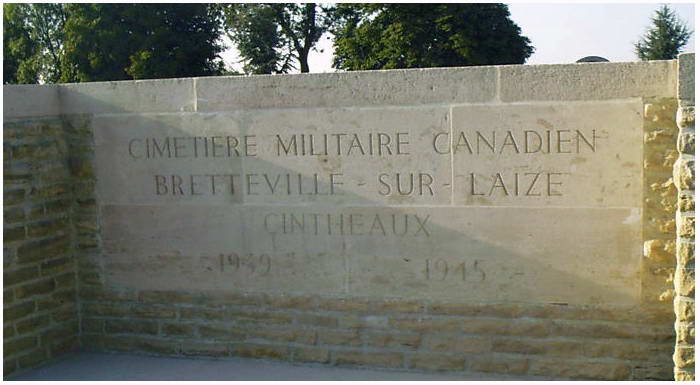
"During the battle he sadly recounted seeing men stand, and firing their weapons, walk towards the enemy till cut down.
They gave as good as they got, he said that they mowed down the German infantry that attacked and forced them back till
they brought up the tanks. Another story he recounted (I recall it may have happened on the way up to Hill 140) was
that the regiment came up on a field of hay that had been harvested and haystacks littered the field, being a
farm boy from Saskatchewan dad reported to Lieutenant Biddlecombe that "it seemed that there was too much hay
harvested on such a small field" !! They then shot into a haystack and out poured German infantry, who had been
laying in ambush!!"
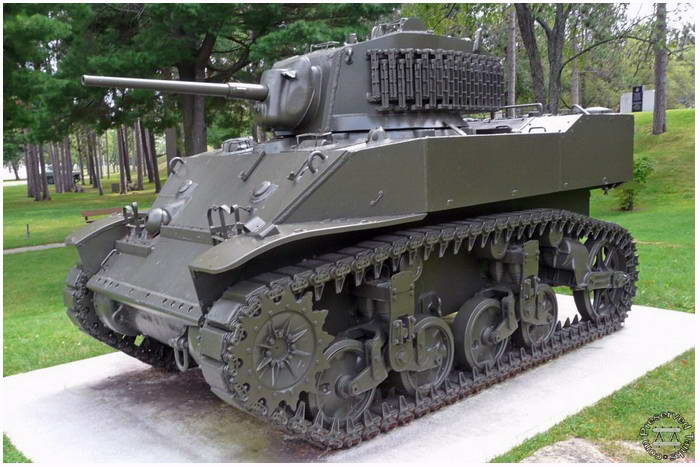
An example of an M5A1 Stuart tank is preserved at the
Base Borden Military Museum, Major General Worthington Memorial Park
(picture: T. Larkum)
"My dad recounted the time when the had to abandon the Stuart tank (the damaged sprocket finally gave out and
he could no longer move the tank), he said that the main gun had been left over his hatch and he could not
get out that way, so he was forced to climb over the motor and escape through another hatch !! He said
normally he could not have done this, but he was well motivated to get out. He had forgot to remove his
headphone and as he jumped down he was yanked back by the cord which gave him quite a jolt,
(he always laughed at this little miss-adventure)."
"As they were over run by the Germans, the infantry and tankers had started to surrender, he decided, with a
small group, to take off and avoid capture and try to get back to allied lines. He and five others ran for the
woods, and as they were making their way through, allied artillery rounds came overhead and one round struck a
tree overhead, knocking them all to the ground. When my dad came around all the others around him were dead.
He continued on till he found a wounded comrade, as they were trying for the allied lines they were captured
by a patrol of SS. The SS were preparing to shoot them when a group of regular German infantry came by and
rescued them from this fate and took them back behind the lines. He was a POW till the Russians liberated the
camp (Stalag 4B), and once again he took off with a pal. Making their way across Germany (they stole a couple of bikes
from some civilian Germans) till they found the American lines and freedom."
"My dad was born Feb. 22,1911, in Saskatchewan and grew up as a farmer on the wheat fields of the prairies,
he then became a west coast logger in British Columbia. When the war started in "39", he volunteered in the
British Columbia Regiment, and was well trained as a soldier/tank driver before going to Europe".
"His wounded friend (I have forgotten his name) survived the war but sadly died a year later after returning
to Vancouver, British Columbia."
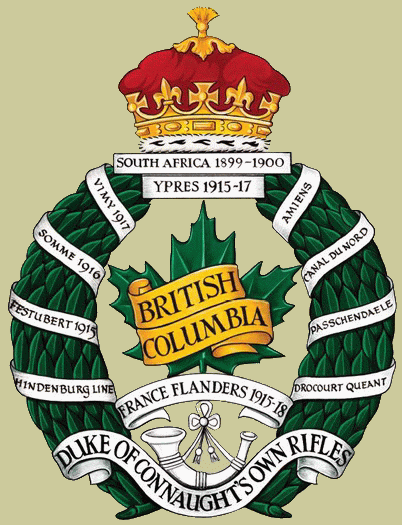
Crest of the British Columbia Regiment
"After the war he went back as a west coast logger, then later in life became a apple orchard grower,then a
store merchant of dry goods, retiring in 1979. He died at age 77, of cancer, on July 4, 1988, in Kelowna B.C.."
"He was not as traumatized by the war, as many were, and always enjoyed the telling of his experiences during the war."
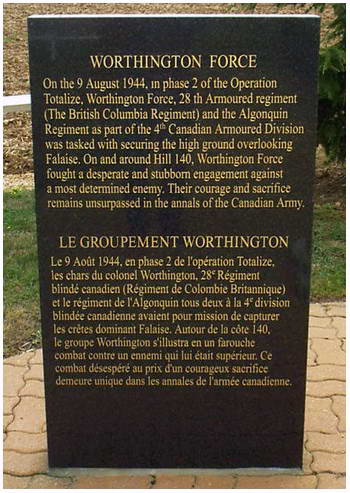
A remembrance stone on Hill 140
"Besides my fathers recollections on the battle, I have read accounts from others that were there.
Some I found in the book "The Dukes" By Douglas E. Harker (a very hard book to find!!)."
These are a couple of accounts from that book (copyrighted material c:1974 The British Columbia Regiment (D.C.D.);
At 2:30 in the afternoon only five BCR tanks and two half-tracks from the Algonquin Regiment remained.
This comment from a survivor's diary will give some idea how conditions were on the hill during the afternoon of
the 9th of August:
"My troop commenced to dig in and Colonel Worthington, Major Baron and Clark organized our defenses and drew up
fire plans, etc. Spirits were excellent and all ranks were jokingly preparing for another "Custer's Last Stand".
Noontime came and except for mortar fire and burning tanks around our perimeters everything was comparatively calm.
Lieutenant Biddlecombe, covered by fire, made a dash for a car full of wounded in which he had moved about the field
in full view, having tanks moved and wounded collected, despite the fact that snipers were shooting from all sides.
He was unhurt and his cool manner, matched by that of Major Baron and the other officers and NCO's kept everyone on
their toes. At 1530 hours infantry scouts reported a German infantry attack coming in over the hill. Everyone was
relishing such an opportunity to get a crack at Jerry and it was a relief from the mortar fire. Lieut.
Art Biddlecombe leaped into his Stuart tank (my Dad's tank) and was the first to engage them.
All tanks that could muster crews pulled out, some protecting flanks, the rest engaging the enemy.
The infantry from their slit trenches, and the crews from burned out tanks assembled a huge arsenal of automatic weapons.
Some slit trenches had as many as three machine guns. A few rifles, stens, pistols and hand grenades.
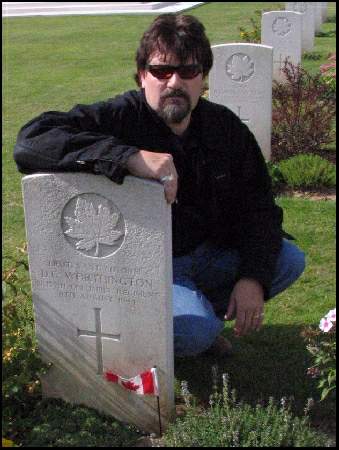
Sean at the gravestone of Colonel Worthington
Lieutenant Clark sat up behind a Browning on a ground mount alternately firing to keep the enemy down and
directing mortar on them to get them up. This attack was driven back with heavy casualties to the enemy but was
soon renewed, this time led by a mix of Panther and Tiger tanks. Lieut-Col. Worthington while moving the wounded
to a less vulnerable position was killed by a burst of a mortar shell. Soon afterwards Major Baron, who had spent
most of the day with him as his strong support, was also killed by mortar fire. It seems fitting that if these two
gallant officers had to die, they should die at almost the same moment within a few yards of each other."
The conclusion of the battle follows in the words of Lieutenant Biddlecombe: (my dad's tank commander)
" We were counter-attacked by what we estimated to be one Battalion German Infantry from all sides (app.1900) from SE side of position.
At this time we had three Shermans in action, one Stuart (mine) plus a few Algonquin and grounded crews.
Right at beginning of the infantry attack one of the three Shermans was knocked out. The enemy never gained our
position until he brought up Tiger tanks. By then the remaining two Shermans were knocked out. Around 1600 we
had a breather when Typhoons came over and strafed and fired rockets into the enemy positions. There were minor
attacks of small groups of infantry and tanks during the day. These were all beaten off. Just before the last
Sherman was knocked out it backed into my tank damaging front sprocket and made steering very difficult. I kept on the
move around our position firing at enemy tanks and infantry on all sides. My 37 jammed and finished the last of 12000
rounds of Browning which I had started with. Tigers had over-run the position and my tank was damaged I ordered crew
to bale out and make a break for it on foot."
The Regiment lost 44 Shermans, 2 Stuart, and one Crusader tank in the battle
Sean
Edmonton, Canada
|